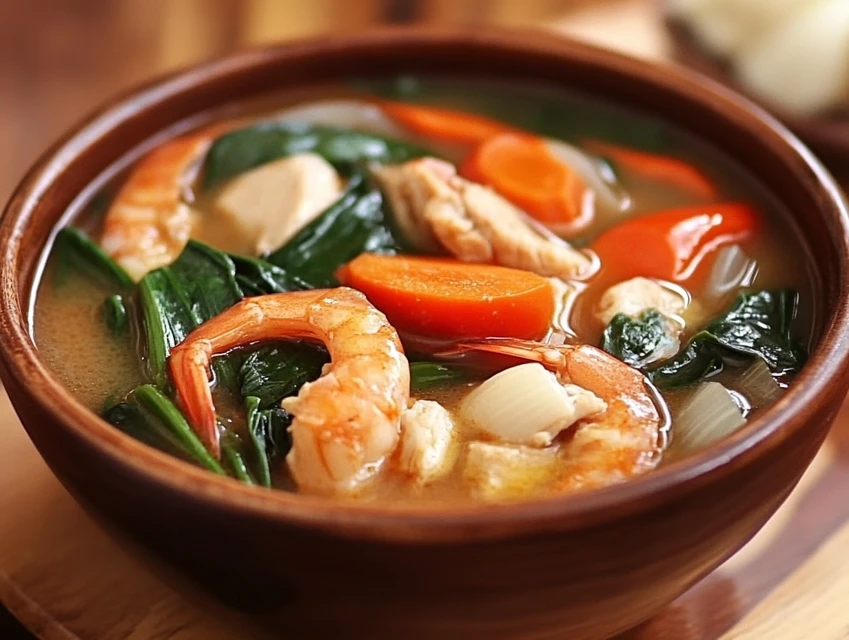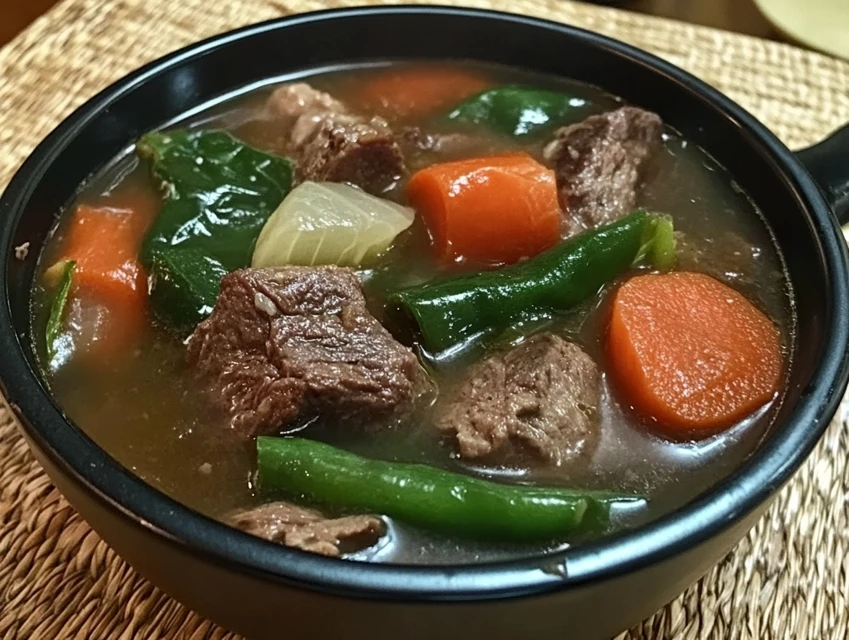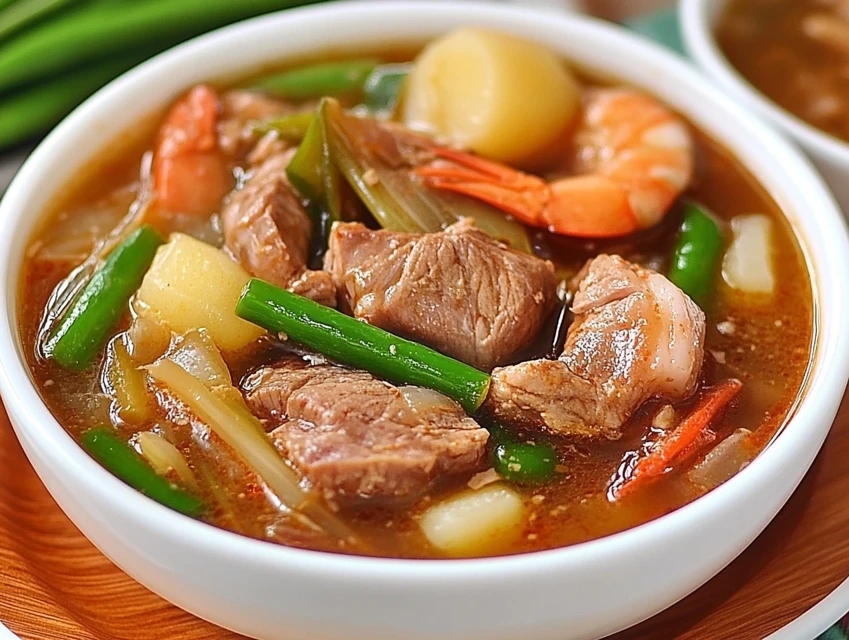Ever wondered why sinigang recipe is so special to Filipino people? It’s not just a sour soup. It’s a mix of flavors where pork belly or pork ribs meet the tangy taste of tamarind. This dish is loved for its flexibility and the way it brings families together.
As we explore making sinigang, you’ll learn about the magic of each ingredient. You’ll also discover the cooking techniques that make it a comforting favorite for many.
What is Sinigang?
Sinigang is a traditional Filipino dish known for its sour taste. It uses tamarind to make a tangy broth. The word “sinigang” comes from “sigang,” which means “to stew.”
This sour soup often has pork belly and vegetables like daikon radish and eggplants. It’s a mix of local herbs and spices that many love. In 2021, TasteAtlas named it the best vegetable soup in the world.
Sinigang is more than just a meal. It’s a symbol of Filipino culture, bringing families together.
The Importance of Sinigang in Filipino Cuisine
Sinigang is more than just a dish in Filipino cuisine; it’s a cultural icon. It’s a comfort food that people enjoy on rainy days or during family gatherings. It brings people together, often served with rice.
Not only is sinigang loved in the Philippines, but it’s also known worldwide. It was named the best soup by TasteAtlas in 2021. It’s also on lists of global culinary favorites, showing the richness of Filipino cuisine.
The sour taste of sinigang, thanks to tamarind, is unique. It captures the essence of Filipino flavors, balancing sourness and savory. This makes it versatile, reflecting the cultural diversity in Filipino cooking. Efforts to support local restaurants during tough times highlight sinigang’s importance in Filipino culture.
Key Ingredients for Making Sinigang
The heart of a great sinigang is in its ingredients. Pork belly and spare ribs are top picks for meat. They add a deep flavor to the broth when cooked for a long time. Together, they form a rich base for the dish.
Meat Choices: Pork Belly, Spare Ribs, and More
Pork belly is my go-to for its tender and flavorful nature. Others might opt for spare ribs or neck bones for extra richness. These fatty parts melt into the soup, making it creamy and savory. Seasoned well, they promise a delicious sinigang experience.
Vegetables Commonly Used in Sinigang
Vegetables are key to a balanced sinigang. Daikon radish, eggplant, and kang kong are favorites. They add different textures and tastes, making the dish more interesting. Together with the meat, they create a colorful and healthy mix.
The Role of Tamarind as a Souring Agent
Tamarind is what makes sinigang special. It can be fresh, paste, or powder. Its tartness balances the savory flavors of pork and veggies. This tanginess is what makes sinigang so loved. Adjusting the tamarind lets me tailor the sourness to my taste, making the meal even better.
How to Make Sinigang From Scratch
Making sinigang from scratch is easy and delicious. It’s a comforting dish great for sharing. First, I prepare the ingredients by cutting the meat and washing the veggies. This step takes about 5 minutes and is crucial for a great sinigang.
Preparing Ingredients for Sinigang
To make sinigang, I choose fresh ingredients and quality meat. Pork belly or spare ribs add rich flavor to the broth. Vegetables like radish, eggplant, and kangkong add color and nutrition. Each ingredient is important for a true sinigang taste.
Cooking Techniques: Simmering to Perfection
Cooking sinigang right is key to its taste. I simmer the meat in a pot with water and tamarind for an hour. This makes the meat tender and the broth sour.
Keeping the simmer gentle is important. It helps all ingredients cook evenly. The whole process takes about 1 hour and 5 minutes. It makes six to eight servings that everyone will love.
Variations of Sinigang
Sinigang is a dish loved by many, with many ways to enjoy it. Each version adds a special touch while keeping the tangy taste. The most loved types use local ingredients, showing what Filipino cuisine is all about.
Sinigang na Baboy (Pork Sinigang)
Sinigang na baboy is all about the rich taste of pork. It uses pork ribs or belly, making it very satisfying. People like to try different sour flavors, like fresh tamarind or guava.
Adding chorizo can make the dish spicy and sweet. It really makes the dish stand out.
Sinigang na Hipon (Shrimp Sinigang)
Shrimp sinigang is a lighter option, focusing on seafood. It keeps the sweet taste of shrimp and the sour broth. Adding watermelon can make the broth look pretty, too.
This dish is perfect for those who want something refreshing. It’s a great choice for a light meal.
Sinigang na Isda (Fish Sinigang)
Fish sinigang lets you get creative with seafood. You can use bangus (milkfish) or other fish. It’s a great way to enjoy local catches.
Adding kimchi can make the dish even better. It adds depth and probiotics. Sinigang na isda is a true reflection of Filipino cuisine.
Sinigang Recipe: A Step-by-Step Guide
Making the perfect sinigang is a fun journey. I start with a detailed guide. First, I collect all the ingredients for sinigang to make cooking easier.
Gathering Ingredients for Your Sinigang Recipe
The key to a great sinigang is using fresh ingredients. I choose 1 ½ pounds of pork, like spare ribs or belly. Then, I pick various veggies like baby bok choy, taro, and string beans.
To get that sour taste, I use tamarind paste mixed with boiling water. A bit of salt and ⅓ cup of fish sauce add depth and umami. These ingredients make the dish truly special.
Cooking the Broth: From Start to Finish
With all ingredients ready, I start making the broth. I sauté onions and tomatoes to create a flavorful base. Then, I add the pork and boiled water, letting it simmer.
Adding tamarind paste at the right time makes the sourness perfect. I let it boil gently for about an hour and forty minutes. This lets the flavors mix well.
Adding Vegetables and Seasoning for Flavor
Once the broth is rich, I add the veggies one by one. I start with taro because it cooks longer. Then, I add baby bok choy later to keep it crunchy.
Finally, I season with fish sauce and pepper. I adjust the seasoning to my liking. This makes the sinigang taste amazing.
Reader Interactions: Share Your Sinigang Experience

Engaging with reader interactions about sinigang opens up a world of sharing. It’s a chance to enrich our culinary world. Share your sinigang experience—like the protein you choose, such as pork, shrimp, or fish.
What veggies do you like in your sinigang? Stick to classics like okra and eggplant, or try new Filipino dishes? I’m curious about any special touches you add to make your sinigang stand out. Your ideas might inspire others to try new flavors.
Philippine cuisine is all about being flexible. By sharing our stories, we grow a community that loves comfort food and traditions. Let’s celebrate our unique sinigang twists. I’m excited to hear your tales!
Storing and Reheating Leftover Sinigang
Knowing how to store and reheat leftover sinigang is key to keeping its flavors. You can keep it fresh for 3 to 5 days in an airtight container in the fridge. This helps reduce waste and offers a quick meal option during the week.
How Long Does Sinigang Keep?
Storing sinigang right is important. I suggest eating leftovers within 2 to 3 days for the best taste and texture. After that, the acid in the dish can break down the pork and veggies. Keeping track of time ensures you enjoy it at its peak.
Best Practices for Reheating Sinigang
Reheating sinigang needs care. The best way is to heat it gently on the stove. This method keeps the ingredients, like veggies, from getting mushy. Adding a bit of water or broth can make it taste fresh again. Reheated sinigang can be just as good as when it’s first made.
Serving Suggestions for Sinigang

Enjoying sinigang is more than just eating it. Thoughtful serving suggestions can make the meal better. A traditional sinigang is best served hot over steamed white rice. This combo makes a satisfying meal that complements the dish’s rich flavors.
I also like to add side dishes to enhance the meal. These extras add texture and contrasting flavors, making the dining experience delightful. Each spoonful of sinigang with these sides satisfies my taste buds.
Pairing Sinigang with Rice and Side Dishes
For a complete meal, I pair sinigang with fried fish or pickled vegetables. These side dishes add texture and contrasting flavors. The mix of hot and cold, tangy and savory, makes for a delightful plate.
Adding Condiments: Fish Sauce and More
I always put out fish sauce (patis) as a condiment. This lets everyone adjust the flavor to their liking. This communal approach enhances flavors and encourages shared moments.
Exploring the addition of fish sauce brings out more depth in the sinigang. It makes the meal more personalized for everyone. Whether serving friends or family, these suggestions create a welcoming atmosphere.
Cooking Tips for the Perfect Sinigang
Making the perfect sinigang is more than just following a recipe. It’s all about the details, especially getting the sourness right. There are some cooking tips that can make your sinigang even better.
Adjusting the Sourness to Your Preference
The tangy flavor of sinigang is key. You can adjust it to your taste. I start by adding a little souring agent at a time to get it just right.
I use fresh tamarind, tamarind paste, green mango, or calamansi. Each one gives a different taste. This way, I can adjust sourness to my liking.
Choosing the Right Souring Agent
The souring agent you choose affects the taste of your sinigang. Tamarind is the most common and has a unique tartness. But, trying other agents like kamias or guava can be fun.
These ingredients change the flavor and add a personal touch. They encourage you to be creative in the kitchen.
Conclusion
My journey making sinigang from scratch has shown me its deep cultural roots and personal ties. This beloved Filipino dish brings warmth and joy to family meals. It’s a comforting staple, filled with tangy flavors.
As I cook the oxtail with fish sauce and add veggies like daikon radish, I see tradition come alive. It’s a beautiful sight.
For those new to sinigang, trying it out can lead to wonderful meals and memories. It comes in many flavors, from classic pork ribs to seafood. Each bowl celebrates the unique sour taste of tamarind or other local ingredients.
Preparing sinigang connects us to Filipino culture, whether you’re an experienced cook or just starting. It showcases the Philippines’ diverse flavors and creativity. Let’s enjoy sinigang together, making meals and moments that warm our hearts.
Suggested Internal Links for Enhanced Reader Engagement
- For a complementary appetizer to pair with your rib roast, check out this Simple Smoked Salmon Crostini Recipe. The smoky, creamy flavors are an excellent prelude to the richness of the roast.
- Interested in exploring other main courses? Try the Perfect Prime Rib Roast Recipe for Special Occasions for a deep dive into prime cuts and cooking techniques.
- Pair your rib roast with a side of comforting bread. Here’s an Easy Southern Cornbread Recipe to complete the meal.
FAQ
What is Sinigang?
Sinigang is a traditional Filipino sour soup. It’s known for its rich flavors and comforting warmth. It’s made with tamarind and often has meats like pork belly or ribs.
Why is Sinigang important in Filipino cuisine?
Sinigang is a beloved comfort food in Filipino cuisine. It’s enjoyed on rainy days or at special occasions. It brings people together, sharing a cultural experience.
What are the key ingredients for making Sinigang?
The main ingredients are meats like pork belly and spare ribs. You also need fresh veggies like daikon radish and water spinach. Tamarind is the key souring agent.
How do I make Sinigang from scratch?
First, gather your ingredients. Then, prepare them. Simmer the meat in a tamarind broth. Add veggies one by one for even cooking.
What are some popular variations of Sinigang?
There are many Sinigang variations. Sinigang na Baboy (Pork Sinigang) and Sinigang na Hipon (Shrimp Sinigang) are favorites. Sinigang na Isda (Fish Sinigang) offers a unique taste.
How can I store and reheat leftover Sinigang?
Store leftover Sinigang in an airtight container in the fridge for 3 to 5 days. Reheat it gently on the stove to keep the flavors intact.
What are some serving suggestions for Sinigang?
Serve Sinigang hot with steamed white rice. It pairs well with fried fish or pickled veggies. Fish sauce on the side lets everyone adjust the flavor.
How can I adjust the sourness of my Sinigang?
To adjust the sourness, change the tamarind amount or use different souring agents. Try fresh tamarind, tamarind paste, or fruits like green mango or guava.

